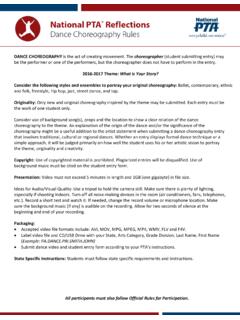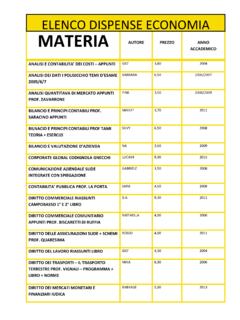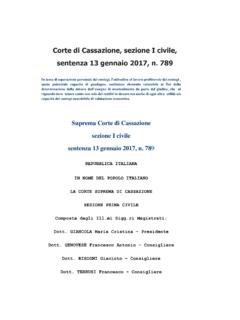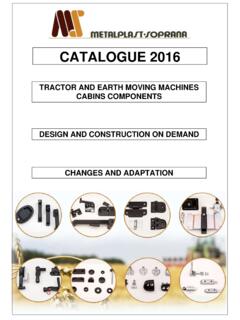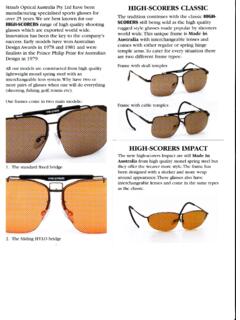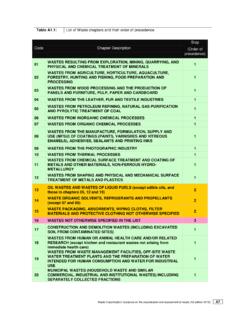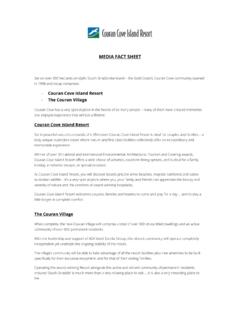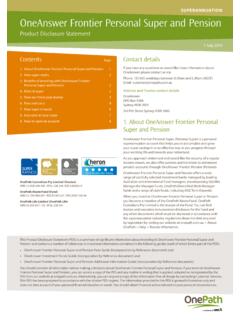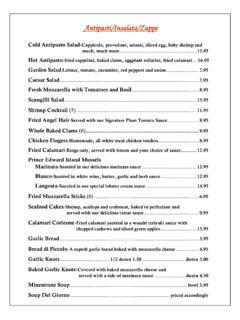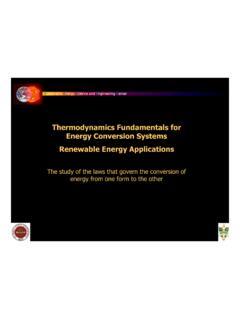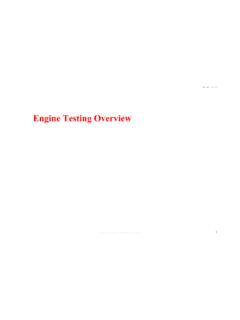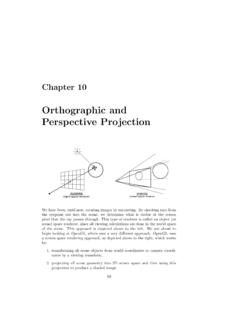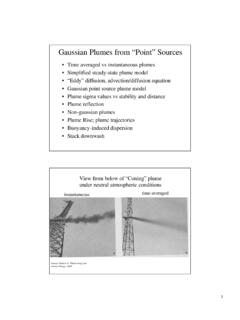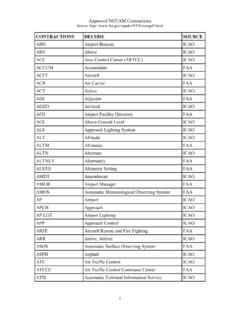Transcription of 17. APPLICATION OF INTEGRATION
1 APPLICATION OF INTEGRATION Measure of Area Area is a measure of the surface of a two-dimensional region. We are familiar with calculating the area of regions that have basic geometrical shapes such as rectangles, squares, triangles, circles and trapezoids. A simple formula could be applied in each case, to arrive at the exact area of the region. In calculating the area of regions on a Cartesian plane, we may encounter regions that do not have such basic geometrical shapes. To compute the area of such regions, we apply methods involving the use of integral calculus to calculate the area. The area bounded by a straight line and an axis The shaded region shown below has a basic shape and its area can be obtained by applying the formula for the area of a triangle. In the diagram, the region, shown shaded as A, is bounded by the straight line =2 , the x-axis and the line =4. When , y = 2(4) = 8.
2 The base of the triangle is 4 units and the vertical height will be 8 units. Hence the area of A square units Now consider the definite integral 2 )* +2 )*=[ -+ ]*) =4- 0- =16 square units We can conclude that the area of the region under the line =2 between =0 and =4 is the same as the integral 2 )* The area under a curve From the above example, we observe that the use of integral calculus enables us to determine the exact area under a straight line. We now extend this principle to determine the exact area under a curve. Consider the function, = ( ) shown below. We can find the area of the shaded region, A, using INTEGRATION provided that some conditions exist. To use INTEGRATION , 1. The region, A must be bounded so that it has a finite area. 2. The curve must be continuous in the interval in which we are interested. Using integral calculus, we can calculate the exact area under a curve using the following formulae.
3 Area under a curve The total area under the curve bounded by the x-axis and the lines = 8 and = - is calculated from the following integral: Example 1 Find the area bounded by the curve , the x-axis and the lines and . Solution It is usually wise to make a rough sketch of the region, whose area is to be determined if one is not provided in the question. A sketch of is shown. 4x=()4,8P\==4 82=1621()xxfxdx 2yx=1x=2x=2yx=Copyright 2019. Some Rights Reserved. 1 of The region, whose area is required, is the shaded part in the diagram shown. Hence, the area required Example 2 Find the area bounded by the curve , the x-axis and the lines and . Solution Area of Measure of volume volume is a measure of space in a 3-dimensional region. If an enclosed region has a basic shape we can use measurement formulae to calculate its volume . Such basic shapes are spheres, cylinders, cubes, cuboids, cones, prisms and pyramids.
4 In our study of measurement, we would have derived formulae to calculate the volume of all these shapes. We have seen earlier that the area of plane figures can be obtained using calculus. When we integrate a function we are really obtaining an expression for the area under its curve. By inserting limits, the region has a definite shape and its area is finite. In this section, we will go one step further and show how we can use calculus to obtain the volume of a solid obtained by rotating a definite region under a curve. The volume of a solid of revolution If we rotate a plane figure about a straight line (called an axis) through a complete revolution or 360 , it sweeps out a three dimensional (3D) region. The shape of the 3D region depends on the shape of the 2D region. The solids obtained by this process are called solids of revolution. The volume of such a solid obtained by rotation is called the volume of a solid of revolution.
5 If a rectangle is rotated through one complete turn about its length, the solid of revolution will be a cylinder. We can visualise a cylinder as the shape swept out by the rectangle as it rotates a full turn of 3600 or one complete revolution or through 2 radians. 2322113xxdxC ==+ 33(2)(1)8 1333312 square units3 =-=- =31yx=+0x=2x=21xxAydx= ()2301xdx=+ ()()2404442020446 square unitsxx =+ =+-+ =Copyright 2019. Some Rights Reserved. 2 of a triangle is rotated through one complete revolution about its vertical height, a cone is formed. Rotation of regions on the Cartesian Plane We can form solids of revolution by the rotation of regions about the vertical or horizontal axes on the Cartesian Plane. If the plane region has a definite shape, then the solid will have a definite shape as well. We will first illustrate how this is done without the use of calculus.
6 Example 1 The region, R, bounded by the straight line y = 2x, the x-axis and the lines x = 0 and x = 3, is rotated through radians about the x-axis. Find the volume of the solid generated. Solution The region has the shape of a triangle and when rotated through radians about the x-axis, a cone will be generated. When , . Hence, P is the point (2, 6). The solid generated is a cone of height, units and base radius, units (see diagram of cone below) We can apply the formula for the volume of a cone to obtain the exact value of the = units3 Example 2 The region, R, is bounded by the horizontal line, , the x-axis and the verticals and . Calculate the volume of the solid formed when R is rotated through 360 about the x-axis. Solution When R is rotated through 360 about the x-axis, the solid generated is a cylinder. The radius, units, and the height, We can apply the formula for the volume of a cylinder.
7 volume volume units3. The diagrams below show the area rotated to form a cylinder. 2p2p3x=()236y==3h=6r=()21633p= 36p=2y=1x=-5x=2r=6h=()2226rhpp== 24p=Copyright 2019. Some Rights Reserved. 3 of Regions with curved boundaries If one or more of the boundaries of the region is not a straight line, then the solid generated may is not a to basic shape and we cannot easily measure its volume by a simple formula. An example of such a region is shown below. The region, R, is bounded by the curve, y, the x-axis and the verticals and . R, is rotated through 360 about the x-axis, between the verticals and . The solid of revolution is shown below. We cannot use the formula, for such a shape as its cross-sectional area is not uniform. To obtain its volume we would find it necessary to apply integral calculus. The volume of a solid of revolution When a region, R, bounded by a curve and the x-axis, between the lines = and = , is rotated through radians about the x-axis, the volume of the solid generated is obtained by the formula: where y is the equation of the curve, expressed in terms of x.
8 A sketch of the solid formed by the rotation is shown below. xa=xb=xa=xb=2p2baVydxp= Copyright 2019. Some Rights Reserved. 4 of 3 Find the volume of the solid generated when the region bounded by the curve, , the x-axis and the lines and is rotated through about the x-axis. Solution The region described in the problem is shown as the shaded area in the diagram. The solid generated may look like the solid shown in the diagram below. Area or region to be rotated volume of revolution The volume of the solid is calculated as: 22+=xy1=x2=x 3602baVydxp= = y212 dx= x2+2()212 dx= x4+4x2+4()12 dx= x55+4x33+4x 12= 625+1023+8 15+113+4 = 615+913+4 =19815 2019. Some Rights Reserved. 5 of 5
